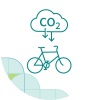Each year we spend around $144m on the transport network to make driving, walking, cycling and busing safer, easier and better for the environment. Currently, there are 177 projects we’re working on and we expect 61 projects to be completed this year.
All of our projects help to make it safer for everyone and better for the environment. It can take up to three years to deliver a project to the community from the concept stage.
Every year we ask for feedback on our progress. Our latest Life in Christchurch Transport Survey told us that while there is still work to do, generally there have been improvements in how easy and safe it is to travel by a range of modes in Christchurch.
How we're going with...
Improving roads by making them safer for all users. Projects include; safer intersections, signals, guard rails and fixing roads and footpaths. Lowering speed limits is also a way we can make roads safer for everyone. Improving roads by making them safer for all users. Projects include; safer intersections, signals, guard rails and fixing roads and footpaths. Lowering speed limits is also a way we can make roads safer for everyone. By implementing safer speed areas in Christchurch we aim to reduce crashes and their severity. These projects are partially funded by the Council and the government. To see more of what we’ve been doing visit our projects page(external link). More people said they are using their car less often, at 26% (n=670) up from 23% the year prior. Positively, 10% (n=269) of respondents who regularly travel by car own or regularly drive an electric or hybrid vehicle. Most respondents find it easy to travel by car in Christchurch (60%, n=1560) because it is the most convenient mode of transport (69%, n=1082) and traffic flows well (39%, n=601). There has been an increase in those satisfied with the condition of our roads, at 30% (n=784), up from 23% in 2020, although there is still work to do to continue to increase satisfaction. There are more people satisfied with the condition of our roads and footpaths, but we still have a lot to do. Council added an additional $10.5 million to the resurfacing budgets for the next three years to ensure that we can improve more of our roads. Next year we’ll start work on the Capital Regeneration Acceleration Facility (CRAF) safety and road improvement projects to improve the roads in several suburban areas of our city impacted by the earthquakes. Public transport improvements, including upgrading the bus hubs at Eastgate and The Palms, improving the real-time information system on our buses and peak-hour bus lanes on Lincoln Road. Over the last year, we’ve delivered public transport improvements including upgrading the bus hubs at Eastgate and The Palms and improving the real-time information system on our buses. Next year we’ll start to build peak hour bus lanes on Lincoln Road to make bus journey times shorter and more reliable to and from the central city and the growing areas of Halswell, Wigram and Hoon Hay. These projects are funded by the Council and the government. We take care of our bus infrastructure - that's things like bus hubs, stops and shelters. Environment Canterbury(external link) is responsible for operating the Metro bus service(external link) - things like bus timetables, routes and fares. The number of respondents travelling by public transport has been decreasing each year, at 24% (n=634) this year, down from 29% in 2020 and 32% in 2019. Of those surveyed, 42% have told us they want more direct routes, 33% want a more frequent service, and 28% want a reduction in fares. We’ve agreed on a 10-year package of funding with our partners to help make public transport more frequent, direct and cost-effective. There’s more than 60km of cycleways. We consider all road users with our cycleways. We look at things like parking/vehicle access, driver visibility and making it safer and easier to walk and use buses. There’s more than 60km of cycleways. We consider all road users with our cycleways. We look at things like parking/vehicle access, driver visibility and making it safer and easier to walk and use buses. We’re currently constructing the South Express cycleway between the central city and Templeton, the Nor’West Arc cycleway between Cashmere and Papanui, and the final section of the Te Ara Ihutai Christchurch Coastal Pathway. Construction on the final section of the Heathcote Expressway cycleway is expected to start next year. A large portion of funding comes from the government. 37% (n=1000) of respondents have travelled by bicycle more than once a month in the past 12 months and of those 26% (n=255) travel by e-bike more than once a month. The latest counts of cycle trips(external link) on our cycleways show the annual growth continues to rise. Our residents’ perception of cycle safety is improving as we continue to build our network of cycleways. We believe that completing a city-wide cycle network is key to continuing this trend. We are also developing and prioritising the programme of work for local cycle connections. This programme of work will see improved connections between the major cycle network and local places of interest, such as schools and shopping centres. To reduce transport emissions, what would Christchurch be like if you could get most of what you need for everyday life within a 15-minute walk or bike ride? To reduce transport emissions, what would Christchurch be like if you could get most of what you need for everyday life within a 15-minute walk or bike ride? Most respondents would be able to walk to a supermarket (59%) or park or open space (94%) within 15 minutes. The majority of respondents report being able to bike to their doctor (56%, n=1255), supermarket (85%, n=1904) and park or an open space (94%, n=2101) within 15 minutes. Conversely, the majority of respondents do not think they could reach their place of work, their place of education or their doctors within 15 minutes using public transport. Find out more on Newsline(external link).

What we've been doing
How people travel
What you've said
What we’re going to do

What we’ve been doing
How people travel
What you've said
What we’re going to do

What we’ve been doing
How people travel
What you've said
What we’re going to do

What we’re thinking
What you've said
